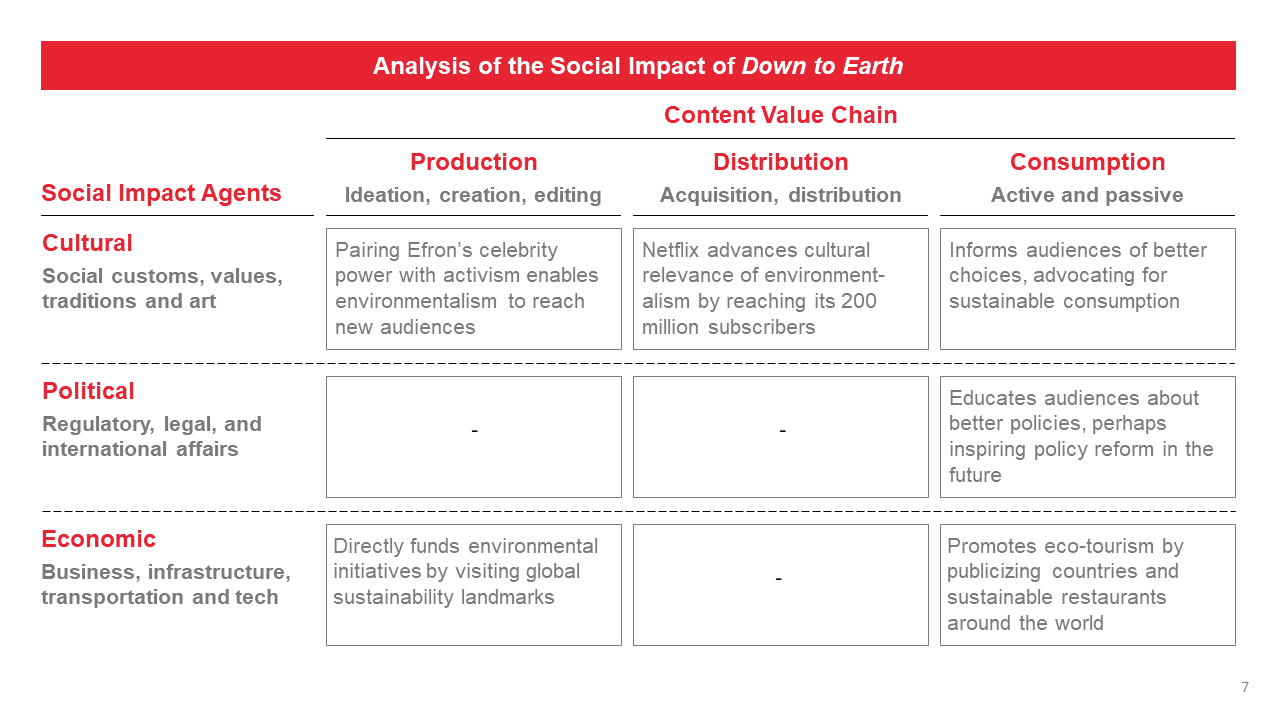About a year and a half ago, I traveled to Tampere, Finland to speak on a panel at the Worldwide Music Expo, where I met a professor who taught a class about the intersection of music and societies. Yesterday, this interaction came full circle when I presented a lecture at his class at Sciences Po, one of the top policy schools in the world. The objective of the lecture was to showcase how music can be used as a platform for social advocacy. However, before diving into specifics, I thought it was important to outline a framework for analyzing the social impact of music. As I continued to workshop the materials, I realized that this framework could be applied to any form of content, not just music, and that it could be invaluable in bridging the gap between media and entertainment, and its impact on society.
Why Do We Need a Framework to Analyze the Impact of Content?
Despite the cultural influence that media and entertainment has on society, the concepts of social impact and consumer content have been at odds since the beginning of time. When people think about entertainment, they think about celebrities and red carpets in the middle of Hollywood. Conversely, when people think about social impact, they think about aid workers and non-profits in Sub-Saharan Africa. How could these two concepts ever be connected?
Leveraging a content-specific framework enables individuals to bridge the chasm between entertainment and impact in a practical way. By doing so, one can proactively predict, or retroactively assess, the social impact of a piece of content.
Embed from Getty ImagesThe Content Impact Matrix
The Content Impact Matrix is a framework for analyzing the social impact of content. The foundation of this framework is a 3×3 matrix that evaluates social impact agents at each stage of the content value chain. By doing so, one can start to identify, value, and measure the social impact of a piece of content.

Social Impact Agents
Along the vertical axis of the matrix are social impact agents, or means through which social impact is created. This is different from the social impact itself. For instance, if a law is passed to fine individuals who don’t recycle, then the law is a the social impact agent, but the impact itself is improved sustainability.
Social impact agents can be categorized into three primary types:
- Cultural: Which could manifest itself through social norms, values, traditions, history, and art.
- Political: Including regulations, laws, tariffs, geo-political affairs, and international relations.
- Economic: This is most obvious through business, infrastructure, transportation, and other technologies that instigate social change.
Stages in the Content Value Chain
Along the horizontal axis are stages in the content value chain. This is inclusive of every step of the content journey, from the moment an idea is seeded in someone’s head, to the moment a global audience tunes in on their iPhones. Social impact agents can be activated at different steps in the value chain to drive social impact in different ways.
The value chain can be broken down into three discrete components:
- Production: Think of this as ideation and creation. This would include activities like hiring staff, writing a script, creating artwork, recording music, or editing videos. This is everything that goes into making the content.
- Distribution: The act of commercializing content. How is it acquired, distributed, and discovered? Is it widely available, or limited to an exclusive, niche audience? Did it go to theatrical distribution, or was it shared online on a personal website?
- Consumption: This can be further broken down into active and passive consumption. Active consumption is content that is actively sought out, whereas passive consumption is more ambient. For instance, seeking out the news to watch it would be considered active consumption, but skimming the headlines on YouTube because the news thumbnails are hovering above the music video you want to watch would be passive consumption. In either case, by consuming that content, an individual is influenced.
Applying This Framework
A few months ago, I wrote about Zach Efron’s environmental docu-series, Down to Earth. Given its focus on nature and sustainability, there is plenty of impact to be drawn out.
Starting with cultural agents at the production stage, Efron’s celebrity power is activated by pairing it with environmentalism, maximizing potential interest. At the distribution stage, Netflix’s scale is activated in a similar way by advancing the series’ relevance by reaching its 200 million subscribers. Lastly, at the consumption stage, the content itself influences social norms by educating audiences about green energy and sustainable food sourcing. Collectively, these cultural agents compound to encourage potentially hundreds of millions to people to adopt a more eco-friendly lifestyle.

Moving onto the next component, political impact agents were left largely untapped at the production and distribution stages of the content journey. If the series’ production or distribution led to some sort of policy reform, there would be more to discuss here. However, when audiences consume this content, it wields an opportunity to inform viewers about international regulations that better support sustainability. By virtue of its subject matter, Down to Earth increases how informed the average person is about environmental policy, thereby improving the likelihood – even marginally – of policy reform in the future.
Finally, looking at economic impact agents, this series is strongest at the production and consumption stages. At the production stage, Down to Earth directly funds environmental initiatives by visiting global sustainability landmarks. From a consumption standpoint, eco-tourism is activated at the macro-level by publicizing entire countries, and at the micro-level by filming rave reviews at sustainable restaurants around the world.

As with all frameworks, this has its limitations. For starters, this doesn’t directly address the potential scale of impact. At a glance, it might be difficult to notice the difference between two pieces of content with wildly different scopes of reach. To mitigate this limitation, one could add a measure for magnitude using proxies such as ratings, sales, views, reach, or even a rough estimate of audience size.
Ultimately, the purpose of this framework is to serve as a guide to thinking through the social impact that a piece of content can have. By applying this lens, we can become more conscientious creators, investors, distributors, and consumers, and can equip ourselves to hold the media and entertainment landscape to a higher standard.
